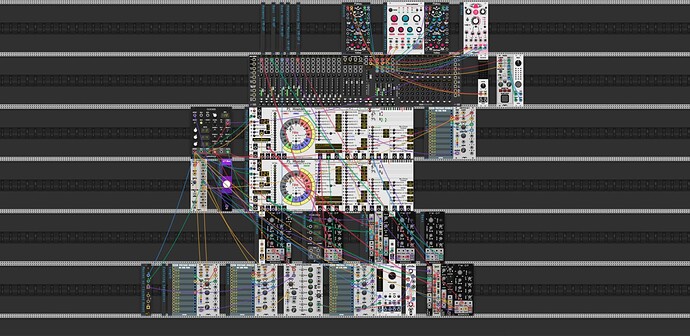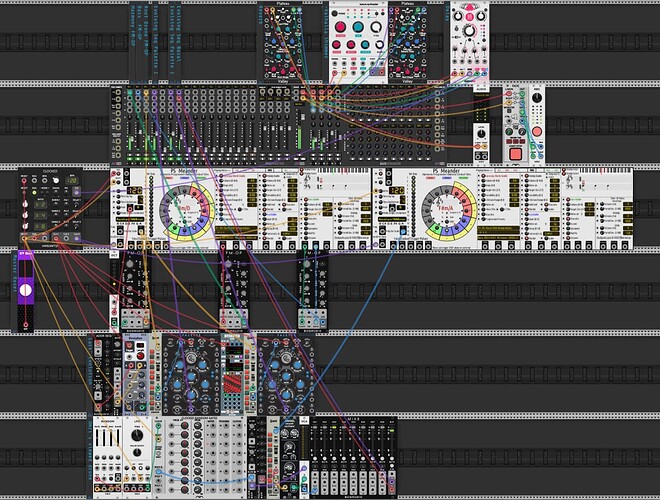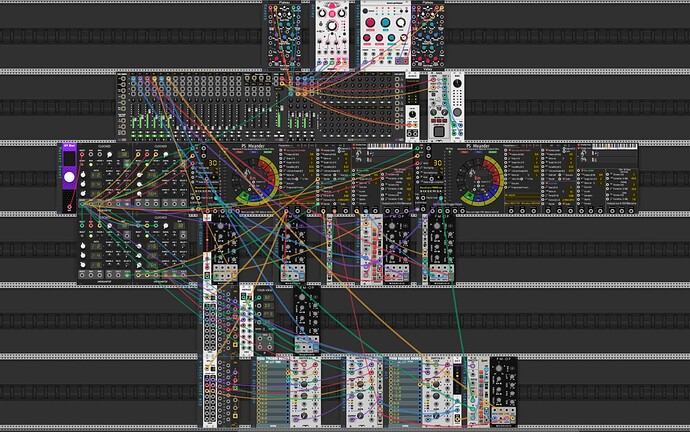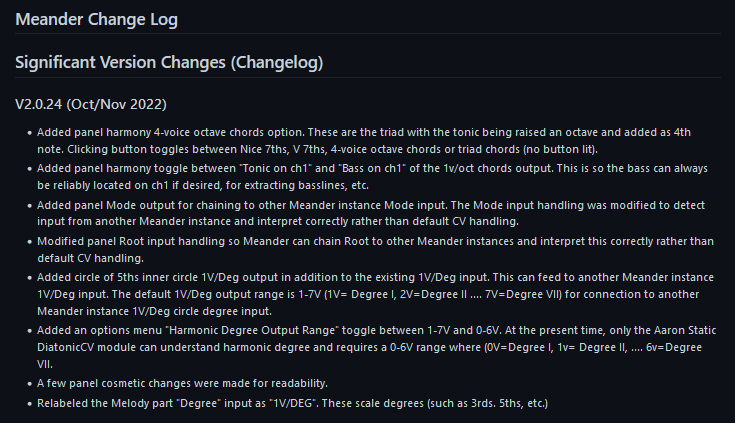my first “job” was building equipment for the neurophysiology lab at UC when I was a student. Best job I ever had. And I could use their drill press and metal shears to make panels for my synths. Pretty sure I “borrowed” those 10 turn knobs from the lab. They weren’t using them…
I did the same ![]() My wah-wah pedal had an aluminum chassis with a wooden pedal that I built in the shop using bandsaw and metal “break” (bender). Bizarrely, most of our raw aluminum stock came from Los Alamos surplus. I got to know Edward Teller fairly well, as he was an adjunct professor at my university. That generation of physicists had some interesting stories to tell. But, it did firm up in my mind which directions in physics I did not want to go.
My wah-wah pedal had an aluminum chassis with a wooden pedal that I built in the shop using bandsaw and metal “break” (bender). Bizarrely, most of our raw aluminum stock came from Los Alamos surplus. I got to know Edward Teller fairly well, as he was an adjunct professor at my university. That generation of physicists had some interesting stories to tell. But, it did firm up in my mind which directions in physics I did not want to go.
My father got his physics phd at UC. Pretty sure he knew teller, too.
I was married and had my first child, so I stopped at my MSc and went to work in industry, even though I had completed a third of my PhD coursework.
Yep, probably every physicist in the US was involved in the Manhattan project. I watched a good movie last week, “Adventures of a Mathematician” about Stanislaw Ulam, Jon von Neumann, Teller and the gang. It was an interesting exploration as told by Ulam of a battle of conscience during that effort.
Here is my newest music piece called “251 is Prime”. This is a long 30-minute generative ambient piece with several degrees of meta-sequencing with each sequencer running at a different clock speed such that the general structure should not repeat for many, many measures. The melody is being generated by Meander but quantized to the Meander pentatonic scale via Grande Quant. The primary ostinato (repeating phrases) are create by arpeggiating the Bmin scale current II-V-I (251) chords in several different ways and evolving over time.
This is at a BPM of 15, using Meander’s clock and divisions of the clock rather than using a clock module.
Here is my latest music “In the Major Minors Sequences”. This takes some of the evolving sequences techniques of others in a separate topic and adds my own take on it… Several types of meta-sequencing are included. Two instances of Meander provide poly external scale output in both B minor heptatonic scale and B minor pentatonic scale. These feed into 2 Grande Quant modules, both of which is switched between the two scales via a slow clock signal. The bottom row of modules is the evolving sequence. The Master Reset button will probably need to be clicked to sync up all of the sequencers and clocks.
Here is the patch if you would like to play with it:
In the Major Minors Sequences.vcv (11.0 KB)
Looks awesome, will definitely have to find a few free hours…er… days… to dig into this! lol
Be sure to read the manual. It is relatively detailed, as manuals go. In the manual there is a “Quickstart” patch that only has 7 functional modules but enables harmony, melody and bass generative music.
Here is my latest music, “Epigenetic Evolution”. This is a continuation of the exploration that several of us have been involved in related to creating nicely and interesting evolving or mutating sequences. This patch is a bit of a Frankenstein where I shamelessly took several contributors’ approaches, chopped them up and mixed with my own approaches. It also includes one of @Omri_Cohen recent techniques for creating slew mixed sequenced drone notes.but also quantized to the same Meander scale, in this case the Bmin pentatonic.
This is in Bmin and has two instances of Meander, one supplying the Bmin heptatonic scale and the other the Bmin pentatonic scale to Grande Quants for quantizing everything to a common scale. So, the evolving sequence is quantized to Bmin heptatonic and the drone sequence to Bmin pentatonic.
Here is the patch if want to play with it and perhaps mix it up even more. Epigenetic Evolution.vcv (10.0 KB)
I just finally got around to trying this module and what a gem! I can’t believe it took me this long to discover it, it will certainly be in many of my future patches.
Here is my latest music, “Cycles”. This previews features from the next release of Meander. In the new version, I implemented a new type of harmonic (chord) progression presets, using a technique called “cyclic progressions”, This is based on the circle of 5ths in which all steps in a given progression preset progress by a specific musical degree. I.E., the progression can step by 5ths, 2nds, 6ths, 3rds, 7ths or 4ths Each progression is 7 steps in length and after 7 steps, the chord is back to where it began. The cyclic progression takes 1 to 6 journeys around the circle of 5ths to get back to where it started.
So, soon there will be 6 additional progression presets available, numbered 60-65. The progression length can be varied from the default 7 down to 1, so the number of variations is 6x7=42.
This song is a cyclic 5ths progression that goes around the circle once per 7 steps.
Cyclic progressions have a different feeling than most traditional variations of I-IV-V chords. There is less of a feeling of progression from tension to resolution. The progression is going somewhere, but really just going in circles. The resolution comes when the progression gets back to its starting point after 7 steps. It should be ideal for ambient foundations.
Here is my latest music, “Ambient Journey”. This goes back to my late 80s’ roots with minimalist ambient generative 30 minutes of relaxation music.
This piece in in B-min and stays on the “I” chord, which is Bm in this case. The Bm chord goes through evolution via inversions and a small amount of fractal Brownian motion (fBm) drift in the octaves. The melody also goes through very slow and small fBm octave drift. Since the bass follows the chords, the bass also slightly drifts. The Meander 3-note chords are converted to 4-note chords with the root doubled in octaves. The 4 chord notes are arpeggiated via Count Module 8-1 sequential switch, which is in turn sequenced by other sequencers for direction changes. OCT is also sequenced. All sequencing is done on nice clock boundaries by the several clock frequencies. Two Meanders are used so both the Bmin heptatonic and pentatonic scales can be output and sent to Grande Quants. Clock signals switch the Quants between the two scales. Several parameters in Meander are clock sequenced.
Thanks to David Grande’s suggestion, this patch makes use of his Tails module to turn mono notes and gate into poly notes and gates so sequential notes can continue to follow their own envelope, independent of each other. This is a nice, simple technique that really helps Meander melody and bass sound better and more natural.
Here is the patch if you would like to play with it: Ambient Journey.vcv (10.5 KB)
As usual, click on the master reset button to sync all sequencers.
That is lovely. My brain insists on playing a military snare over the top of it, but I think that’s my problem rather than yours. ![]()
Interestingly enough, I had drums including snare in the patch but took them out since they are VCV paid modules. I thought the drums sounded good, but kept asking myself “Really… drums in ambient?”. ![]()
Purr Software Meander V2.0.23 has been submitted for library review and build.
There are only two changes in this release:
- LED buttons were changed to flat shading rather than 3D shading.
- 21 new harmonic progression presets were added, mostly aimed at ambient music. See the manual end for the description and details for all 80 presets. The new presets are numbered 60-80.
Have fun making Meanderthal music ![]()
Purr Software Meander V2.0.24 has been submitted for library review and build. Here are the changes in this version:
After compiling (Windows 10 Pro under MSYS2) and putting the latest version in the plugins folder, VCV crash… sorry, didn’t keep the log file…
Have you successfully built Meander for Windows before?
And are you building from my GitHub V2 branch?
Yes





